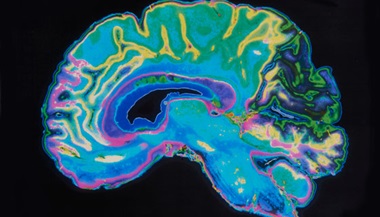Sympathectomy
What is a sympathectomy?
Deep inside your chest, a structure called the sympathetic nerve chain runs up and down along your spine. It is the part of the nervous system responsible for the fight or flight response. During a sympathectomy, a surgeon cuts or clamps this nerve chain. This keeps nerve signals from passing through it.
Why might I need a sympathectomy?
This procedure is used to treat a condition called hyperhidrosis or abnormally heavy sweating in the palms of the hands, the face, the underarms, and sometimes the feet. It's also used for facial blushing, some chronic pain conditions and Raynaud phenomenon — a condition that leads to profound sensitivity to cold temperatures and color changes of the skin. After a sympathectomy, the brain can't send signals to the involved areas to make them sweat, blush, or react to the cold as much. This permanent procedure is used as a last resort if other steps, such as antiperspirants or medicines, haven't worked.
What are the risks of sympathectomy?
As with any surgery that requires anesthesia, risks include breathing problems or reactions to the medicines used to help you relax during the procedure. Other possible risks include:
- Bleeding
- Infection
- Pain
- More sweating in other parts of the body
- Stroke or heart attack during the procedure
- Collapsed lung
- Pneumonia
- Need for extended time on a breathing machine
- Injuries to nerves or blood vessels during the surgery
- Weakness in the arms
- Burning sensation on the underside of the arms
- A problem called Horner’s syndrome, which is caused by nerve injury, and leads to eyelid drooping and trouble with the pupils of the eye.
- Surgery does not relieve the problem
You may have other risks, based on your specific medical condition. Be sure to talk with your healthcare provider about any concerns you have before the procedure.
How do I get ready for a sympathectomy?
Ask your healthcare provider to tell you what you should do before your sympathectomy. Below is a list of common steps that you may be asked to do.
- Along with a complete medical history, your healthcare provider(s) may do a physical exam to ensure you are in otherwise good health before you undergo the procedure. You may also have blood tests and other diagnostic tests.
- Your healthcare provider will explain the procedure and you can ask questions.
- You will be asked to sign a consent form that gives permission to do the procedure. Read the form carefully and ask questions if something is unclear.
- Tell your healthcare provider(s) if you are sensitive to or are allergic to any medicines, latex, iodine, tape, contrast dyes, and anesthetic agents (local or general).
- Tell your healthcare provider(s) of all medicines (prescribed and over-the-counter) and herbal supplements that you are taking.
- If you are pregnant or think you could be, tell your healthcare provider(s).
- Tell your healthcare provider(s) if you have a history of bleeding disorders or if you are taking any anticoagulant (blood-thinning) medicines, aspirin, or other medicines that affect blood clotting. You may be told to stop some of these medicines before the procedure.
- If you smoke, stop smoking as soon as possible before the procedure to improve your chances for a successful recovery from surgery and to improve your overall health.
What happens during a sympathectomy?
Before the surgery, you will be given medicine (anesthesia) so you go to sleep. You won't feel or remember the procedure. The surgeon will make 2 to 3 small incisions (cuts) on one side of your chest below your underarm. Next, your lung will be temporarily collapsed and moved aside to allow the surgeon to reach the nerve chain along your spine.
The surgeon will then insert a small video camera and surgical tools to view and maneuver the nerve chain. Next, the surgeon will cut or clamp the nerve chain at the right level, depending on your exact symptoms.
When finished, the surgeon will re-expand the lung, remove the camera and instruments, and sew shut the incision. Then the surgeon will repeat the procedure on your other side. The entire surgery takes about an hour.
Talk with your healthcare provider about what you will experience during your sympathectomy.
What happens after a sympathectomy?
After the procedure, you will be taken to the recovery room for observation. Your recovery process will vary depending on the type of procedure done and the type of anesthesia that is given. The incision sites will be checked often. Once your blood pressure, pulse, and breathing are stable and you are alert, you will be taken to your hospital room.
Most people can go home the day after the surgery. You should plan to have someone give you a ride home.
You may resume your normal diet unless your healthcare provider advises you differently.
You may feel pain for a week afterward. Your healthcare provider may suggest that you take over-the-counter or prescription pain medicine.
Ask your healthcare team how to keep the incisions clean. Avoid soaking in the tub or going swimming for 2 weeks.
You can probably do your normal activities after the surgery. But, you may need to take it easy at first. No heavy lifting or vigorous exercises until your body has healed.
Most people can return to work within a week.
Be sure to take all of your medicines as prescribed and to attend any follow-up visits that your healthcare provider schedules.
Next steps
Before you agree to the test or the procedure make sure you know:
- The name of the test or procedure
- The reason you are having the test or procedure
- What results to expect and what they mean
- The risks and benefits of the test or procedure
- What the possible side effects or complications are
- When and where you are to have the test or procedure
- Who will do the test or procedure and what that person’s qualifications are
- What would happen if you did not have the test or procedure
- Any alternative tests or procedures to think about
- When and how will you get the results
- Who to call after the test or procedure if you have questions or problems
- How much will you have to pay for the test or procedure





